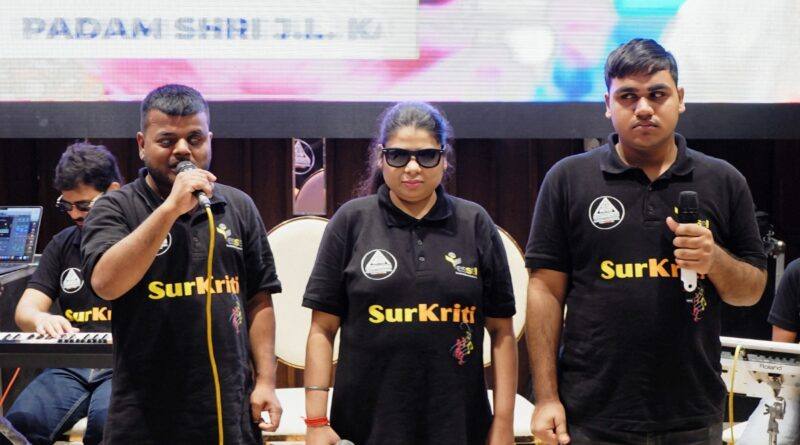Differently Uplifting: See This World Better Through Their Eyes
By Wilfred Melwyn | Art & Culture | The WFY Bureau
Khilte Chehre: Charting New Journeys for the Visually Impaired in India

In a country as culturally rich and geographically diverse as India, travel has never merely been about transport. It is a rite of passage, a form of liberation, and a deeply personal encounter with one’s own identity. For many, the roads they travel become lines etched into memory. But for a significant section of the population, especially the visually impaired, this joy has remained out of reach, not for lack of desire but due to lack of inclusion.
In an inspiring and much-needed intervention, Khilte Chehre, a social initiative founded by travel entrepreneur Amit Jain and supported by collaborator Subhash Verma, is changing that narrative. The project is reimagining tourism for India’s visually impaired by giving them the means to experience the country’s wonders through their remaining senses — touch, sound, texture, rhythm and interaction. These journeys are not about helping the differently-abled. They are about equal participation in the human experience of exploration.
Reimagining Accessibility: A Cultural and Human Rights Imperative
India is home to over 2.68 crore persons with disabilities, as per the 2011 Census. Of these, around 50 lakh individuals are visually impaired, with millions more living with low vision or degenerative eye conditions such as retinitis pigmentosa, glaucoma or diabetic retinopathy. Yet, only a handful of public transport facilities, heritage sites or tourist destinations across the country are equipped to offer a truly inclusive experience.
While the Rights of Persons with Disabilities Act, 2016 mandates accessibility and non-discrimination, its implementation remains uneven. According to a 2023 study by the National Centre for Promotion of Employment for Disabled People, over 70 per cent of tourist facilities in India remain structurally inaccessible to persons with disabilities. Tactile pathways, accessible signage and inclusive programming are still largely missing.
It is in this landscape that Khilte Chehre has emerged as a grassroots response. It does not wait for government reform but moves forward with empathy, ingenuity and action.

A Movement Rooted in Human Experience
The idea behind Khilte Chehre is simple yet powerful. Travel is a right, not a privilege. Amit Jain, with over two decades of experience in the travel and tourism sector, wanted to apply his expertise to a section of society that has historically been left behind in this domain.
Together with Subhash Verma, he built an experience-focused model that places dignity and agency at the heart of every journey.
This is not an occasional charitable tour. It is a long-term initiative aimed at empowerment. The name Khilte Chehre, which translates to “Smiling Faces”, reflects the very spirit of the venture – to evoke joy, confidence and meaningful connection in every traveller, regardless of physical limitations.
Human Stories Behind the Movement
Among the most touching examples of the movement’s impact are Amar Jain and Meenakshi Chaturvedi, a visually impaired couple who met through common support networks. Their chemistry is palpable. They often complete each other’s sentences and share an unmistakable warmth that stands out at any public event. Their love story is a beautiful defiance of the common stereotypes associated with disability and relationships.
For them, Khilte Chehre is more than a travel group. It is an enabler of freedom, romance and shared memory. It gives them space to be partners in adventure, not just in life. Whether walking through the chilled air of Shimla or feeling the stone textures of ancient forts in Rajasthan, they travel not as passengers but as full participants in the cultural richness of India.
Another inspiring participant is Bhagyashree, a 27-year-old woman who lost her sight to retinitis pigmentosa, a rare genetic disorder that gradually deteriorates the retina. Once a spontaneous traveller who loved driving through mountain roads, Bhagyashree now builds new memories with friends she met through Khilte Chehre. “I thought I had lost the road forever,” she says. “But this is a new way of travelling — a way that speaks to my other senses, to my emotions.”

What Makes the Experience Unique?
Unlike traditional sightseeing tours, which centre around visual elements, Khilte Chehre designs multi-sensory travel experiences. Destinations are chosen not just for their aesthetic value, but for their soundscapes, temperature changes, tactile appeal, smells and the presence of storytelling potential.
Participants are accompanied by trained volunteers, local storytellers and audio guides who describe the history, mythology and emotional context of each location. There is emphasis on interaction with locals, cultural immersion through music and food, and guided movement that honours individual pace and agency.
Whether walking barefoot on riverbanks, touching ancient temple carvings or listening to the call of distant birds at sunrise, travellers “see” the world in ways sighted individuals often miss.

From Disability to Possibility
At the core of Khilte Chehre is a redefinition — that disability is not about deficiency, but about different ability. The initiative seeks not to make things easier, but to make things meaningful.
Each itinerary is carefully crafted. It includes adapted infrastructure, trained guides and a deep understanding of the unique needs of every participant. The aim is not to simplify the experience, but to enrich it — making it personal, inclusive and above all, empowering.
This ethos is what makes Khilte Chehre an initiative of empowerment rather than exception. Unlike many projects that offer symbolic gestures for inclusion, this one is focused on systemic empowerment. Participants are encouraged to give feedback, share stories and even guide future tours. Some alumni of the tours have now become part of the organising committee, creating a loop of leadership and self-representation.
The Broader Context: Inclusion as Cultural Practice
Tourism contributes nearly 9 per cent to India’s GDP and generates over 42 million jobs. However, the Accessible India Campaign (Sugamya Bharat Abhiyan), launched in 2015, has made slow progress. Out of 1,000 identified public buildings to be made accessible by 2022, only about 35 per cent have seen completion, as per recent reports from the Ministry of Social Justice.
Meanwhile, countries like Japan, Sweden and New Zealand have successfully implemented sensory tourism projects as mainstream practice. India, with its rich sensory heritage — the smell of masalas, the rhythm of folk dances and the touch of cotton saris — has enormous potential to lead the global movement on inclusive tourism.
Khilte Chehre has become a living example of what this future might look like.

Beyond the Tour: A Ripple Effect
The impact of Khilte Chehre goes far beyond the days spent on the road. For many participants, these journeys rekindle a sense of purpose, reconnect them with their passions and build networks of solidarity.
Families report changes in confidence levels, greater willingness to go outdoors and improved mental health outcomes among their loved ones. The sense of isolation often experienced by persons with disabilities is replaced with a sense of community.
Local tourism businesses that collaborate with Khilte Chehre also benefit by learning how to create accessible spaces. In turn, this gradually changes the broader industry’s attitude towards inclusion.
Changing Perceptions: From Awareness to Action
Perhaps the most powerful contribution of Khilte Chehre is the quiet shift in public perception it brings. As participants move through railway stations, hotels, public gardens and heritage sites — laughing, sharing and asking questions — they demand to be seen not as sufferers, but as explorers.
In doing so, they teach society a valuable lesson. Inclusion is not about sympathy. It is about designing systems that leave no one out.
Looking Ahead
Khilte Chehre is now in the process of building alliances with state tourism departments, accessibility NGOs and corporate sponsors interested in CSR-led inclusive travel models. Their goal is to expand operations across 15 states in the next three years, reach 10,000 beneficiaries and create a training curriculum for sensory tourism professionals.
It is an ambitious goal, but if their journey so far is any indication, it is grounded in care, clarity and deep commitment.
Concluding Thoughts
In a world obsessed with visuals — selfies, likes and screens — Khilte Chehre reminds us of another kind of vision. It is a vision that listens more deeply, touches with care and travels with intention.
Their work is not just a travel programme. It is a social movement, a quiet revolution that redefines who gets to belong in the story of exploration. And for every visually impaired traveller who feels the wind in their hair atop a hill, or the warmth of sunlight through temple walls, that revolution is already a reality.
To know more or support:
Website: https://risingstarkhiltechehre.org/index.php
Disclaimer: This article has been independently written for The WFY Magazine under the Art & Culture section. It is not a sponsored or paid feature. All facts are drawn from verifiable sources at the time of writing, and personal names have been included with consent or as publicly available information. Readers are encouraged to verify ongoing developments through the official website of the initiative.




